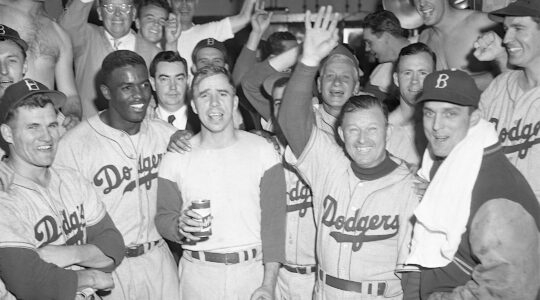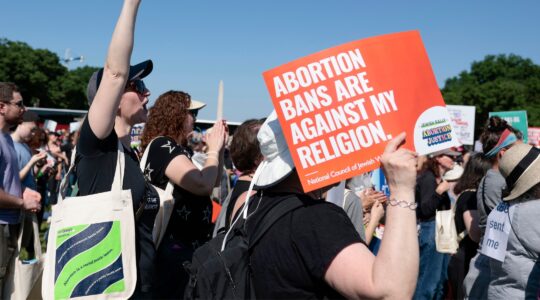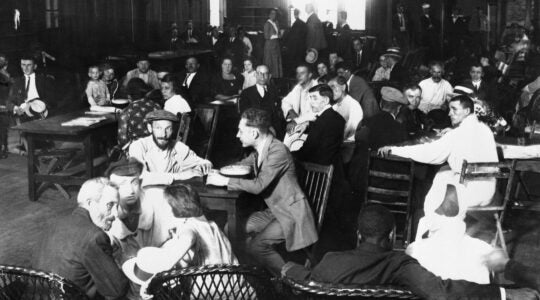WASHINGTON (JTA) — After many decades of being excluded from most history books and Holocaust museums, the 1940s’ rescue activists known as the Bergson Group are finally receiving the recognition they deserve. That’s important to ensure historical accuracy, to promote Jewish unity and, most of all, to help inspire a new generation of activists.
As an Aug. 7 feature story in The New York Times noted, the Bergsonites "shook America" with their hundreds of newspaper advertisements, rallies and lobbying on Capitol Hill for U.S. action to rescue Jews from the Nazis. The group’s leader, Peter Bergson (real name: Hillel Kook) called himself a "nuisance diplomat," and his activities indeed were quite a nuisance to the Roosevelt administration, which claimed that the rescue of European Jews was impossible.
Many mainstream Jewish leaders likewise were uncomfortable with the Bergson rescue campaign. They were afraid that loud Jewish activism might provoke anti-Semitism. Some Jewish leaders were worried, too, that the media-savvy Bergson was stealing the limelight.
Despite their opponents, the Bergsonites succeeded in mobilizing enough congressional and public pressure on President Roosevelt to help bring about the belated creation of a new U.S. government agency, the War Refugee Board, in early 1944. During the final 15 months of World War II, the board played a key role in rescuing about 200,000 Jews from the Nazis.
Bitterness over Bergson’s provocative tactics lingered long afterward, however, which may partly explain why for many years, most narratives of the Holocaust omitted Bergson. It didn’t help that the Bergson Group dissolved itself in 1948 — Bergson quipped that it was the only Jewish organization to ever voluntarily go out of business — meaning that Bergson alumni weren’t well positioned to ensure their story was accessible to historians or the general public.
But times changed. In the 1970s and 1980s, a new generation of historians, led by professors David S. Wyman and Monty Penkower, began writing about the Bergson Group. More recently, an off-Broadway play called "The Accomplices" and several film documentaries have brought the story to whole new audiences. The U.S. Holocaust Memorial Museum recently added Bergson materials to its permanent exhibit, as did the newly expanded and reopened Los Angeles Museum of the Holocaust and the National Museum of American Jewish History in Philadelphia.
And this summer, on the 70th anniversary of the Bergson Group’s establishment, Yad Vashem in Jerusalem (together with The David S. Wyman Institute for Holocaust Studies) co-hosted its first symposium on the activists.
Another factor contributed to the changing attitudes toward Bergson: the legitimization of Jewish activism. The Bergson tactics that some Jewish leaders deplored in the 1940s were adopted by the mainstream Soviet Jewry protest movement of the 1960s and 1970s. When the Bergsonites organized a march by 400 rabbis to the White House in 1943, it was considered radical. Today, Jewish rallies in the nation’s capital — whether for Israel or Darfur — are commonplace.
Why is it important that the change has finally come?
First, setting the record straight is vitally important as a matter of principle. Jews take history seriously; omission of the Bergsonites did the historical record a terrible disservice.
Second, correcting the omission can play a healing role in the Jewish community. Recognition of the Bergson Group helps put to rest the bitter quarrels of yesteryear. By facing up to its past, American Jewry can learn from the tragedies caused by the disunity of the Holocaust years.
Third, some of the specific actions of the Bergsonites are surprisingly relevant all these years later. Darfur activists seeking the arrest of indicted Sudanese President Omar Bashir might find useful ideas in Bergson’s successful 1945 effort to shame the State Department into agreeing to prosecute all Nazi war criminals. Governments today that are reluctant to shelter refugees might learn something from the Bergson campaign for temporary havens for Jews fleeing Hitler. Jewish political activists in Washington can learn a great deal from the activities of the Bergson Group, which was arguably the first ‘Jewish lobby’ in the nation’s capital.
Most of all, recognizing the activists of the Holocaust era is important because the Bergson story offers a powerful lesson for our time about the need to respond actively to oppression. The ultimate purpose of studying the Holocaust is not merely to learn about the past, but also to ensure that the mistakes of the past are not repeated.
We live in an era when genocide and threats of genocide are all too real. The Bergson Group and others who promoted rescue in those days can serve as moral role models to ensure that this generation does not stand idly by.
(Rafael Medoff, the director of The David S. Wyman Institute for Holocaust Studies, is editor of the new book "Millions of Jews to Rescue: A Bergson Group Leader’s Account of the Campaign to Save Jews from the Holocaust," by Samuel Merlin.)





